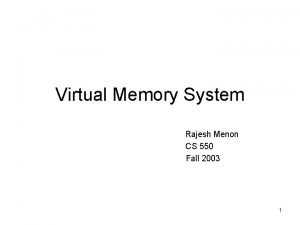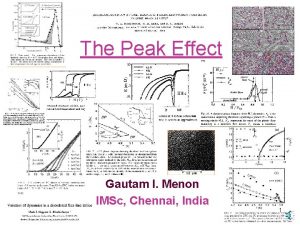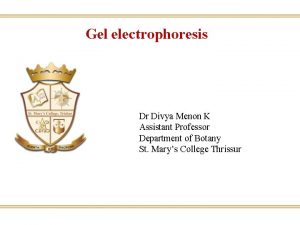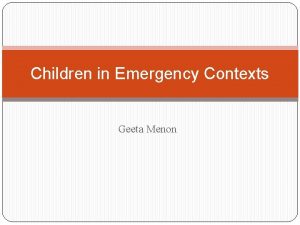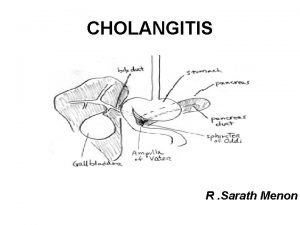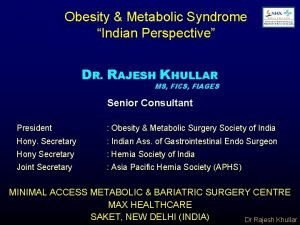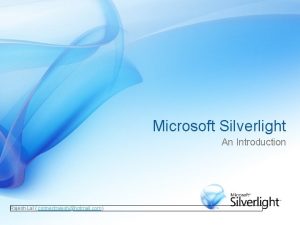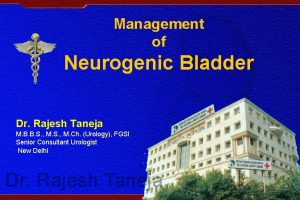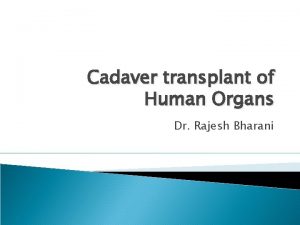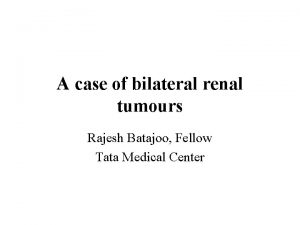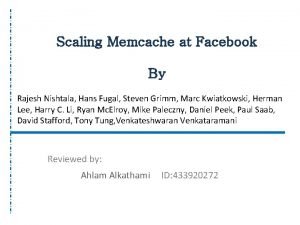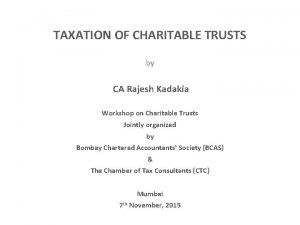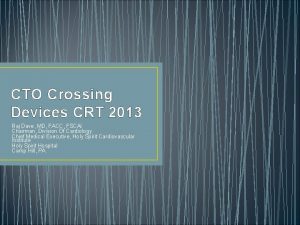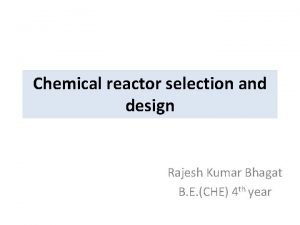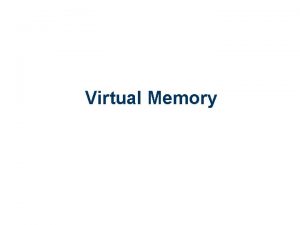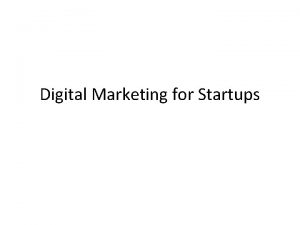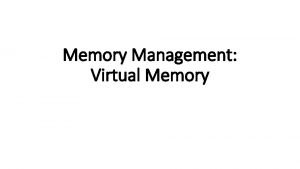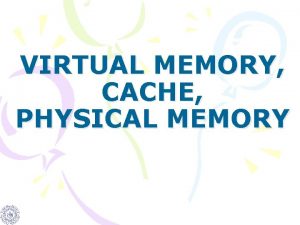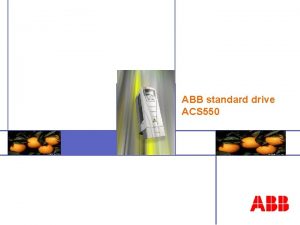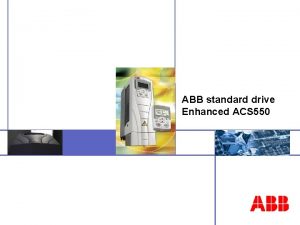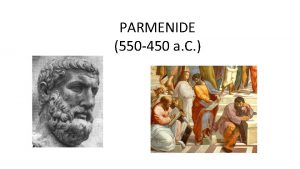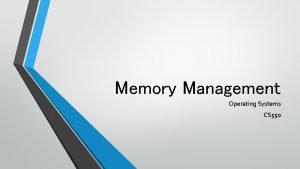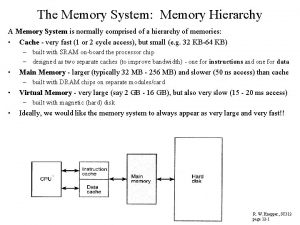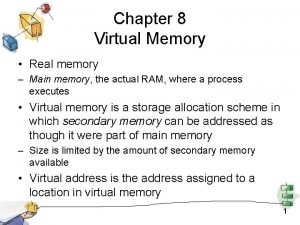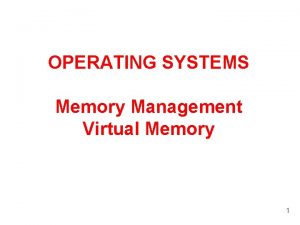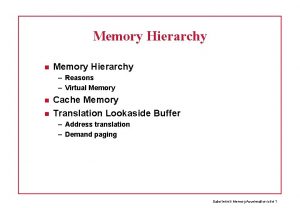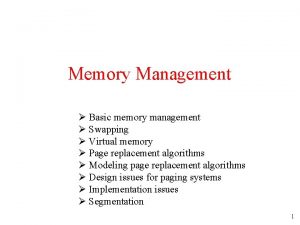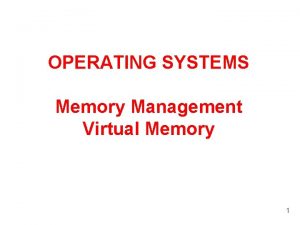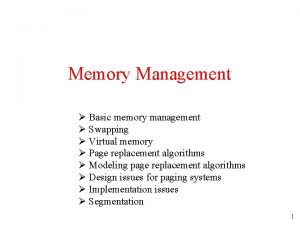Virtual Memory System Rajesh Menon CS 550 Fall


























- Slides: 26

Virtual Memory System Rajesh Menon CS 550 Fall 2003 1

Topics Covered in this study Ø VMS • History • Future? Ø The Processor Mode and the Process • Processor Modes • Process States • VMS OS model • Scheduling • SMP 2

Topics Covered in this study (cont’d) Ø Memory Management • Demand Paged Virtual Memory • Memory management subsystem Ø VMS data structures • Process Data Structures • Memory management Data Structures Ø Process Synchronization • Process Synchronization between two processes • Mutual Exclusion of Critical Regions 3

DEC VMS Ø Gained importance from 1980 – 1990 Ø VMS touted to be a leading-edge technology • Virtual Memory • 32 bit address space • 128 bit floating point number precision • Batch, Interactive and real-time processing Ø DEC was taken over by COMPAQ and COMPAQ later merged with HP. 4

History DEC Operating Systems First Generation Computer OS Major Features Time sharing OS, Static partition of the available physical memory. OS in Programmable Digital Processor (PDP-1) Major Disadvantage: Job-to-partition size had to match. OS in later generations of Time sharing OS, Dynamic partition of Programmable Digital Processor (PDP the available physical memory. -6, PDP-8) Major Disadvantages: External Fragmentation due to the lack of contiguous memory for process allocation. 5

History (cont’d) OS in PDP-10 Re-locatable partition allocation: Hardware solution to problem of fragmentation in the form of base register and bounds register. Mapped memory: memory address space seen by the program need not be the physical address space used. Second Generation Computer OS RSTS OS on PDP-11 General Purpose, time sharing, Multiuser OS. Paged Memory management. 6

History (cont’d) Third Generation Computer OS VMS (Virtual Management System) on VAX (Virtual Address Extension) Demand paged virtual memory. Modern Age Computer OS SMP, Clustering. Open. VMS 7

Layered Operating System Processor Modes Original figure © 1992 by Van Nostrand Reinhold. 8

Process States Original figure © by 1990 Professional Press, Inc. 9

Wait State Ø Voluntary Wait States: Current Process • HIB or Hibernate State • LEF or Local Even Flag • CEF or Common Event Flag • SUSP : A process need not be current (exception) Ø Involuntary Wait States • FPG or Free Page Wait • PFW or Page Fault Wait 10

Process Scheduling Ø VMS can accommodate Batch, Interactive and Real-time processes Process Type Priority Level Batch Process 3 Interactive Process 4 -9 Real-time Process System Manager’s Discretion 16 and above 0, 1, 2, 10, 15 11

Process Scheduling (cont’d) Ø VMS scheduling is preemptive based on the priority Ø First-Come-First-Out (FIFO): Batch processes or processes with similar priority, Free list, Modified list Ø Round Robin: Employed by Short-term Scheduler Ø Shortest Job First (SJF): Print queue Ø Shortest Remaining Time (SRT): variation of SJF Ø Aging 12

Process Scheduling (cont’d) Scheduler is invoked under these circumstances. • System Event Occurs: Short-term Scheduler or Medium-term Scheduler • Quantum expires: Short-term Scheduler • Perform wait service: Short-term or Medium-term Scheduler 13

Memory Management Ø Demand paged virtual memory system: Mitigates shortcomings of partitioned memory Ø Process has a virtual address on creation Ø Process and Physical Memory divided into pages of 512 bytes in size. Ø Mapping : Virtual address translated to physical address Ø Translation-not-valid Exception Ø Principle of Locality – Active pages Ø Working set (Resident Set): set of active pages, LRU algorithm with reference bit, size varies 14

Memory Management (cont’d) Ø Memory Management Subsystem • Page Fault handler • Moves pages from disk to the resident set • Local page replacement strategy • Page management algorithm • Swapper • • Lack of physical memory for new processes Whole idle process is swapped: Swap File Page File: Modified pages HIB state until awakened 15

Page Management Algorithm Copyright © 1997 by Butterworth-Heinemann 16

Page Management Algorithm (cont’d) 17

Page Management Algorithm (cont’d) 18

Process Data Structures Ø Process Context • Software Context: Process Control Block (PCB) • Name, state, priority, event flags • Links for the linked lists • House keeping fields: block type, length • Pointers to JIB and PHD • Asynchronous System Trap (AST) Control Block • Software Context: Job Information Block (JIB) • Represents the tree structure forming the parent and child processes 19

Process Data Structures (Cont’d) Ø Hardware Context: Process Header (PHD): includes hardware PCB • Resident set of processes • P 0 and P 1 page tables • Hardware PCB: stacks, registers, base and length registers Ø Virtual address space: S 0, P 1 regions 20

Memory Management Data Structure VAX Address Format 21

Memory Management Data Structure (cont’d) VMS Page Table Entry 22

Memory Management Data Structure (cont’d) Original table © 1997 by Butterworth-Heinemann 23

Process Synchronization Ø Synchronization between two processes • Hibernate – Wake: System services • Event Flag: Set Event Flag, Clear Event Flag, Wait For Event Flag • Mailbox: I/O between processes Ø Mutual Exclusion of Critical Region • Lock and Unlock system service: Semaphore 24

VMS: Advantages and Disadvantages o Advantages • ‘One architecture, one operating system’ • VAX implementation of peer-to-peer relationship o Disadvantages • Totally a CISC architecture and prominence of RISC architecture • VAX assembly language • Flaw in the implementation of IPL • Poor management of the problem of critical selection 25

VMS: Advantages and Disadvantages (Cont’d) o Future… • Open. VMS • DEC Alpha • HP’s systems with Intel’s new 1. 5 GHz Itanium 2 chips: rx 4640, rx 7620, rx 8620 26
 Memory management
Memory management Virtual memory and cache memory
Virtual memory and cache memory Virtual memory in memory hierarchy consists of
Virtual memory in memory hierarchy consists of Venu menon md
Venu menon md Gautam menon imsc
Gautam menon imsc Bourgeoisie definition
Bourgeoisie definition Dr divya menon
Dr divya menon Dr geetha menon
Dr geetha menon Dr asha menon
Dr asha menon Dr sarath menon
Dr sarath menon Virtual memory in operating system
Virtual memory in operating system Virtual memory
Virtual memory Scope of traffic engineering
Scope of traffic engineering Transportation engineering by rajesh bhagat
Transportation engineering by rajesh bhagat Bmi 35 female
Bmi 35 female Silverlight seminar ppt download
Silverlight seminar ppt download Neurogenic bladder
Neurogenic bladder Naga rajesh tummala
Naga rajesh tummala Dr rajesh bharani
Dr rajesh bharani Dr rajesh batajoo
Dr rajesh batajoo Sarcoidosis
Sarcoidosis Scaling memcache at facebook
Scaling memcache at facebook Kadakia caste
Kadakia caste Rajesh shah thoracic surgeon
Rajesh shah thoracic surgeon Rajesh shewani
Rajesh shewani Raj dave md
Raj dave md Rajesh kumar bhagat
Rajesh kumar bhagat
